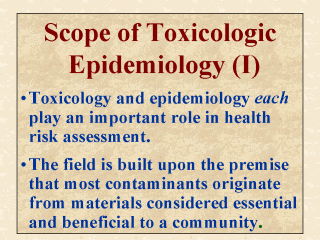| front |1 |2 |3 |4 |5 |6 |7 |8 |9 |10 |11 |12 |13 |14 |15 |16 |17 |18 |19 |20 |21 |review |
 |
Throughout this
series, toxicologic epidemiology is defined as the study of the frequency and distribution
of adverse human health effects caused or modified by toxic agents or harmful materials.
As stated in the title slide, such a one-liner definition is indeed too simplistic for
something representing a highly complex health science discipline. According to a classic collection by Goldsmith (1986), much of environmental epidemiology has a focus on the use of epidemiologic methods to investigate community environmental health problems. That objective is too broad for toxicologic epidemiology, and does not bring out the important role of toxicology. Nor does it embrace the critical step in which the identified or confirmed association between certain human disease and the exposure to an environmental agent should be put into action. That is, identifying or establishing etiologic environmental contaminants is only the beginning of a long journey to tackling a community environmental health problem. Health risk assessment (RA) is built upon the premise that all materials are hazardous if used unwisely or excessively, and that most environmental contaminants originate from materials or products that are considered essential or beneficial to a community. Therefore, the knowledge acquired that a contaminant can induce an adverse health effect per se is not an environmental health concern. This knowledge becomes a public health problem only if there is a (potential) risk involved. And that risk should be above an acceptable level or a benchmark in order for it to be considered a public health concern. |